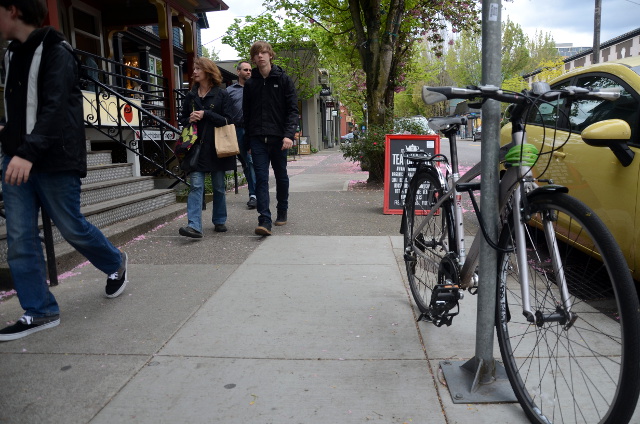
(Photos: M.Andersen/BikePortland)
Part of NW Portland Week.
Almost every map or chart you will ever see of “where people commute by bike” is incomplete.
Nineteen times out of 20, it’s based on only half of the picture: the locations people commute from. In the United States, we make almost no effort to calculate where people are bike-commuting to.
Little-known fact: according to the best data available, almost nowhere in Portland brings in a larger percentage of its commuters by bicycle than the lower section of Northwest 21st and 23rd, between Marshall and Burnside.
You can only find this information in an obscure Census dataset maintained by the association of state transportation engineers. But according to that estimate, about one in 10 of the 3,000-odd people who work on these 24 city blocks got there by bike during the years 2006-2010, the most recent available.
That’s double the estimated rates for the Lloyd District or downtown Portland.
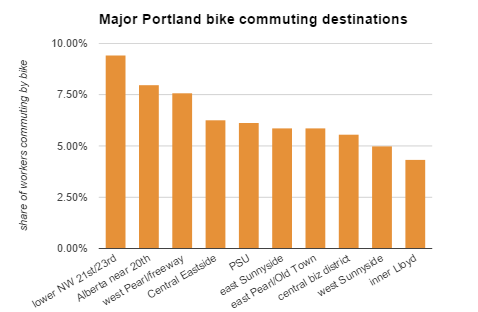
(Data: CTPP 2006-2010. Chart: BikePortland.)
One in 10 employees of this little Census tract isn’t actually a lot of bike commuters: just a few hundred, barely enough to fill a secure bike parking area at Portland State University. That’s why nobody notices them.
But hidden in the fact that the Northwest District has a large share of bike commuters is an important fact about bike transportation in general.
To be sure, Portland has changed a lot since this data was collected. But take a walk or ride through this little corner of northwest Portland and you’ll see the sort of employers that don’t often make headlines as bike-commuting powerhouses, but are secretly the bedrock of American bike commuting: neighborhood retailers.
More specifically: bars and restaurants.
One in 10 Portland jobs (and one in 11 jobs nationwide) is some form of food service. And across the United States, an estimated 2.9 percent of people who work at “eating and drinking places” get to their jobs by bicycle. The only major employer category that comes close to that level of bike commuting are colleges and universities.
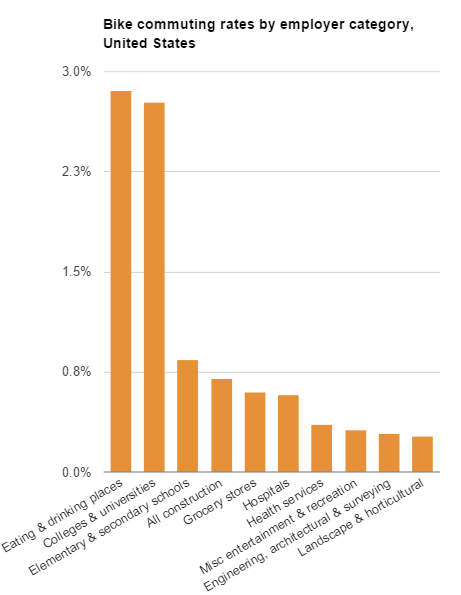
You’ll almost never see this fact mentioned by pro-bike politicians, urban planners, biking advocates or journalists, who love to talk about tech workers. But the combination of low-ish incomes, odd hours, youth and (probably) an affinity for after-work hijinks has made food service workers the footsoldiers of American bicycle transportation.
And that’s made the lower Northwest District, a dense hub of bars and restaurants with mediocre transit and terrible parking, a significant Portland bike commuting destination despite the area’s near-total lack of bike infrastructure.
It’s enough to make you wonder how much biking there would be if the bike infrastructure were actually improved.
Advertisement
On Tuesday afternoon I walked down 23rd from Overton toward Burnside, asking in each shop if any employees were bike commuters. Here are the first four bike commuters I met, in order.
Alfredo Reyes
Reyes, 27, has been the manager at Little Big Burger for three years. He was given his first bike by his father, a biking buff who once biked across several states in his native Mexico.
Reyes lives near Portland State University and is also taking business administration classes from Portland Community College. On one day, he has to get from class to Northwest in 10 minutes; on those days he drives his car. Other days, he bikes.
“I really love bikes, and I believe in sustainable cities and saving a lot of natural resources,” Reyes said. He added, self-deprecatingly: “Probably that’s my super liberal thing.”
Reyes said that when he gets “philosophical” about his commute, he bikes because of the “sense of freedom” — “you feel your own being,” he said.
Reyes mentioned that he’s also proud that his commute preserves urban space.
“I read an article that a car takes up 25 square feet,” he said. (Note: It’s probably more like 250, but it wasn’t important to his point.) “Times two for work and home. Times three for school. People in developing countries live in 50 square feet.”
Mark Nunziata
Nunziata, 35, is a barista at Barista, the award-winning coffee joint. He’s been biking in Portland since he first moved here in 2001 to attend PSU, and was soon involved in biking activism, “Critical Mass stuff.”
“It was a very different scene back then,” he said. Biking was his main transportation from then until 2005, when he moved home to Vermont for a few years. There, he got interested in motorcycles, and started building those into his commute when he returned to Portland in 2009.
He lives in north Portland and now usually uses truck and motorcycle, but just bought a “sweet new road bike” to bike-commute this summer.
“Being at work at 5:30 in the morning does not help your motivation to start pedaling when the truck and motorcycle are staring me in the face,” he confessed.
One of Nunziata’s main frustrations about bike-commuting to Nob Hill is the lack of comfortable east-west routes.
“I’ve done it tons of times and I still don’t think I’ve got a good way to get from the Steel Bridge across Naito and into Northwest Portland,” Nunziata said. “How cool would it be if we had a Going Street here? Stop signs, speed bumps — it’s almost like cars aren’t welcome. It’s great.”
Jason Elstad
Elstad, 34, is a cook at the cafe Papa Haydn. For the last three years, he’s been biking seven and a half miles each way to work from his home near 82nd and Fremont.
“I come in and I pass everybody who’s stuck in traffic, and I’m coming home and I pass everybody who’s stuck in traffic,” he said happily. “Not paying for parking is a huge bonus.”
A bike racer in his spare time, Elstad sometimes worries about parking his bike at work, which doesn’t offer secure bike parking. But he hasn’t had any problems yet.
Ann Greisser
Greisser, 52, works the counter at Escape from New York Pizza, a restaurant she started biking to as a customer more than 30 years ago. A Portland native, her first bike-commutes were to high school and Portland State University.
These days, she’s working two food service jobs, seven days a week. That includes four double shifts that keep her busy from 6 a.m. to 11 p.m.
“I bought a condominium and I’m just trying to work my savings back up,” she said. “I don’t mind working. I like where I work. These are casual places.”
Her late and early shifts mean she doesn’t have good public transit to and from the Pearl District home she bought after many years of saving. She could walk, but feels safer on a bicycle.
“You get your sketchers” when you’re a woman walking solo through northwest, Greisser said, especially after 11 p.m. Actual problems have been rare, but on the bike she can cruise past drunken frat boys and aggressive street dwellers alike.
Greisser says biking in Portland has gotten worse as the streets have gotten more crowded.
“I used to enjoy it more,” she said. “My friend and I would get off at 11 and we would do a night ride out to Sauvie Island. That was in the 90s.”
Today, Greisser described herself as “a cautious rider.”
“I can’t afford to get hurt,” she said.
— Michael Andersen, (503) 333-7824 – michael@bikeportland.org
Our work is supported by subscribers. Please become one today. .



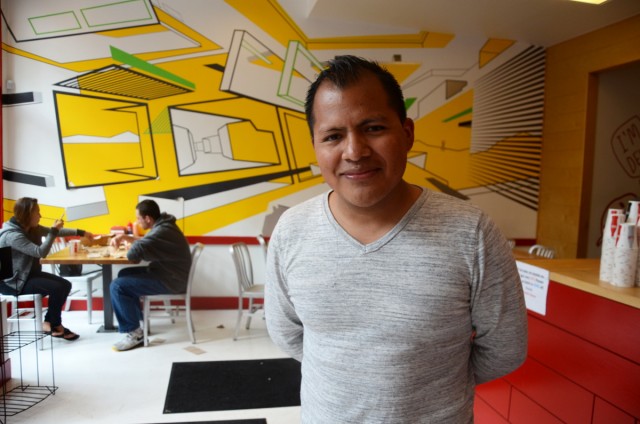
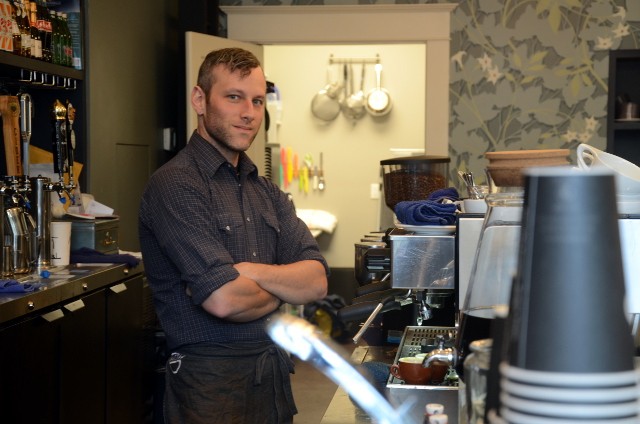
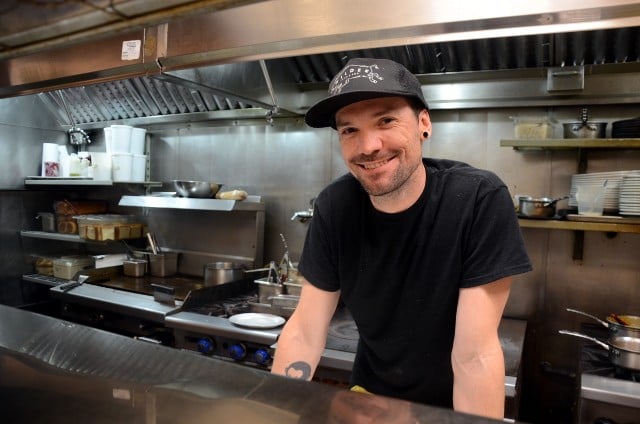
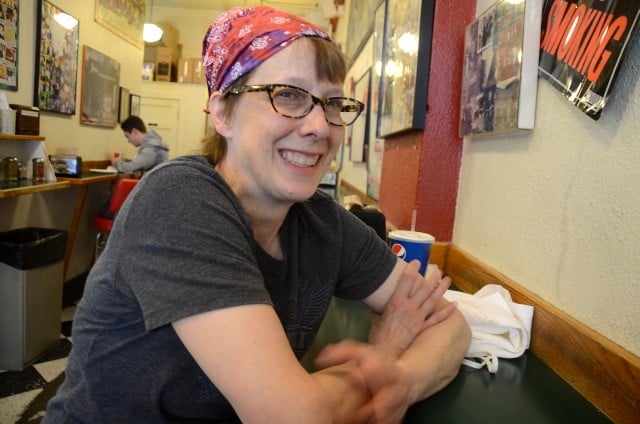
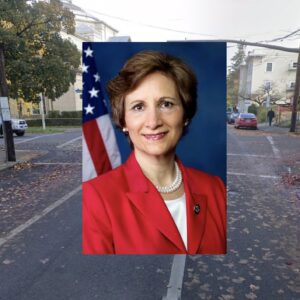
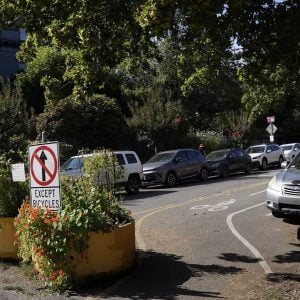
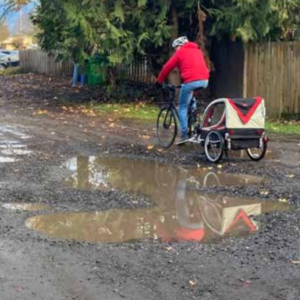
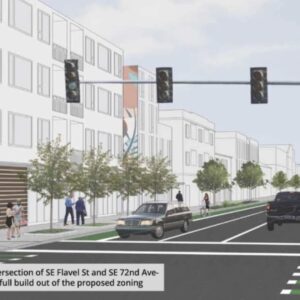
Thanks for reading.
BikePortland has served this community with independent community journalism since 2005. We rely on subscriptions from readers like you to survive. Your financial support is vital in keeping this valuable resource alive and well.
Please subscribe today to strengthen and expand our work.
maybe another reason eating and drinking places get so many bike commuters is that there are lots of them and that gives people a choice where they want to work. If you are going to work at a eating and drinking place why not pick one close by if you can? Although Jason’s commute sounds pretty badass.
I wonder, what is the biking rate for drunk drivers who lost their licenses? Aside from those who keep driving illegally, of course…
That might be a thing in NC but it’s not like that here. Most other commuters I know do it for the love of cycling, the environment, the cost factors, and the freedom it provides.
that might be self-selection going on.
I mean, I know several cyclists are are conservative gun owners who go to church regularly and don’t really care about environmentalism. They just like to ride bikes. There really are all types.
Actually the commute to and from work is the one trip that many drunk drivers with suspended licenses still drive and they do so legally. In oregon it is fairly easy to get a hardship permit allowing you to continue driving to and from work.
“I still don’t think I’ve got a good way to get from the Steel Bridge across Naito and into Northwest Portland”
Right now, there isn’t a good way. The Flanders Greenway would fix that. I really hope PBOT is successful with their Connect Oregon grant application.
Much more on this subject coming up tomorrow morning…
Looking forward to it.
Michael – thanks for shining a [bike] lamp on this under documented commute group…often the “ninja” commuters one sees late at night but never hears/ sees at bike / transpo meetings.
I hope the NW merchant group would include some future support and energy behind establishing infill all weather secure bike parking for this class of employees.
[I remember how creative the discussion of transportation management solutions were back in the late 90’s in the NW [Nob Hill] was…]
For a lot of lifetime bike users it’s not about undesirable weather as much as it is about leaving a desirable bike unattended for hours in such popularized areas. Of course beater bikes are one answer but. . . .
Still a mighty hassle locating, repairing and dealing with revolving door univegas and peugeots, not to mention that “whats the point of this s**t” feeling harshing my “it’s still a bike” delusion as I roll rusty past real bikes on my way out the door.
It would be nice to have centralized covered lockup facilities for bikes.
Unfortunately these often serve as vectors for opportunists seeking easy availability of bikes and accessories. Maybe to the point of requiring continuous ninja video surveillance? I sure wouldn’t want to be employed to personally watch over such a lockdown in such a lucrative environment.
I just read a great book somewhat related to this
“The Bicycle Coyote”
RW
Can confirm; used to work at a bar in Chicago and I took the brown line ‘L’ to work in the evening, and the 24/7 red line ‘L’ most of the way home in the early morning, then used bike share for the last two miles (as the brown line had already stopped for the night by then). Had a coworker who lived closer to the red line and would just take that home, but after hearing about my positive experiences with bike share started cycling home instead for fitness/weight reasons. Commuting by bike at 4am is a really different animal! I adopted it quickly as cheaper than a taxi but much safer than walking.
dusk and dawn rides are nice, 5am summer rides with a light chill.
mmmmmhmmmm
Another reason for higher bike commute rates might be that food service jobs often begin or end at time when there is no transit service.
But according to Amanda Fritz, all those people drive! 😛
Sounds like these biking people have some history doing it. How would more people in these situations (early/late shifts, lower wages) get started biking? Bike share?
Thanks for doing these bike commuter profiles. I enjoyed reading them!
Wow, IPUMS as a journalistic data source! (And to reveal something interesting, no less). You’ve really out-wonked yourself this time, Michael. Well done!
Haha, Elstad. He’s good people.
Great article, Michael!
Completely overlooked is correct.
And a very useful as a tool for studying bikeability, and using as a pointed instrument to help government make wise monetary investments to enhance bikeability.
Folks, there’s lots of new “discoveries” to be made in science and social science, just waiting for someone to sleuth them out. Then everyone has a “oh, duh, why didn’t I think of that” moment. Then uses the new theories, types of data collection, etc, to make the world a better place.
Keep your neurons firing, wonk away, don’t be afraid to throw around new ideas, and be sure to blog about the ones you have.
Ted Buehler
M.S. Transportation Technology and Policy
The ways to identify new theories, patterns, means of collecting data are to keep your brain open, and when something kinda bothers you about someone else’s methodology, chew on it. Figure out why it bothers you. Articulate it. Sober or inebriated. Alone or with friends. With people that agree or with people that disagree.
Michael’s observation here could have been kicked in years ago, and put into service for many useful investments already.
I recall Roger Geller’s brownbag lunch in 2008 about “Cyclezone analysis” — breaking down the city into groupings of areas with a comparable quality of bicycle infrastructure.
The map and story is here.
http://bikeportland.org/2008/10/23/cycle-zones-will-help-plan-future-bikeways-9635
While the overall concept and presentation were good and useful (and tried to open up a new tool for planning), it was noted by someone in the audience that many of the commute destination neighborhoods were simply left out of the study, like Swan Island and everything north of Columbia Blvd? (They are blank on the map). This could have been a gateway for Roger or anyone else to say “aha! That’s a pretty good idea! Let’s start inventorying everything weighing destination as well as origin” but it didn’t take.
Hopefully Michael’s proposition that this be included as a metric will “take.”
Thanks Michael,
(And thanks to the (many?) other people who tried to open up this concept over the history of bicycle planning and research but wasn’t able to describe it as well as Michael and actually get it out the door and rolling).
Ted Buehler
Hopefully if interest in mode share by commute/general trip destinations rather than origins takes off we’ll end up with better data. The margin of error for the cycling count to census tract 48 is more than 50%.